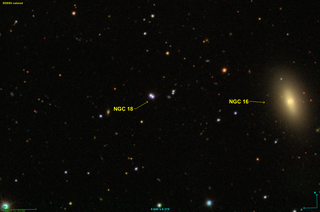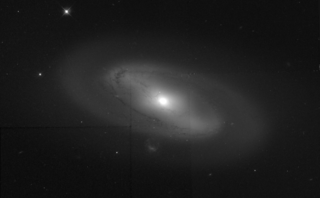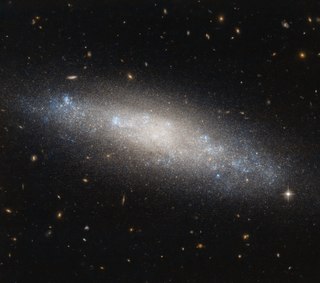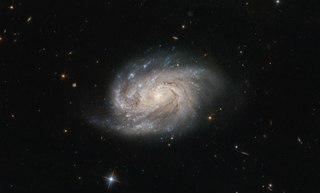
NGC 7635, also known as the Bubble Nebula, Sharpless 162, or Caldwell 11, is an H II region emission nebula in the constellation Cassiopeia. It lies close to the open cluster Messier 52. The "bubble" is created by the stellar wind from a massive hot, 8.7 magnitude young central star, SAO 20575 (BD+60°2522). The nebula is near a giant molecular cloud which contains the expansion of the bubble nebula while itself being excited by the hot central star, causing it to glow. It was discovered in November 1787 by William Herschel. The star BD+60°2522 is thought to have a mass of about 44 M☉.
NGC 6756 is a small open star cluster in the constellation Aquila, close to NGC 6755.

NGC 18 is a double star system located in the constellation of Pegasus. It was first recorded by Herman Schultz on 15 October 1866. It was looked for but not found by Édouard Stephan on 2 October 1882. It was independently observed by Guillaume Bigourdan in November 1886.

NGC 1723 is a barred spiral galaxy in the constellation Eridanus. The galaxy is listed in the New General Catalogue. It was discovered on September 13, 1863, by the astronomer Albert Marth.

NGC 1725 is a lenticular galaxy in the constellation Eridanus. The galaxy is listed in the New General Catalogue. It was discovered on November 10, 1885 by the astronomer Edward Emerson Barnard.

NGC 6304 is a globular cluster in the constellation Ophiuchus. William Herschel discovered this star cluster using an 18.5-inch (47 cm) f/13 speculum reflector telescope in 1786. It is about 19,000 light-years away, near the Milky Way's central bulge.

NGC 3199 is an emission nebula in the constellation Carina. It is commonly known as the Banana Nebula. The object was discovered in 1826 by the Scottish astronomer James Dunlop. It was thought to be the bow shock around the central star, WR 18, an especially hot and luminous Wolf–Rayet star; however, it was determined that the nebula formed due to the composition of local space, not because of the star's movement.

NGC 7199 is a barred spiral galaxy registered in the New General Catalogue. It is located in the direction of the Indus constellation. It was discovered by the English astronomer John Herschel in 1835 using a 47.5 cm reflector.

NGC 2300 is a lenticular galaxy in the constellation Cepheus. It was discovered in 1871 by French astronomer Alphonse Borrelly using an 18 cm telescope.

NGC 6902 is an unbarred spiral galaxy located in the constellation of Sagittarius at an approximate distance of 131.80 Mly. NGC 6902 was discovered in 1836 by John Herschel.

NGC 4260 is a barred spiral galaxy in the constellation Virgo. It was discovered by William Herschel on April 13, 1784.

NGC 3741 is an irregular galaxy in the constellation Ursa Major. It was discovered by John Herschel on March 19, 1828. At a distance of about 10 million light-years, it is located in the M94 Group. It is relatively undisturbed by other galaxies.

NGC 3705 is a barred spiral galaxy in the constellation Leo. It was discovered by William Herschel on Jan 18, 1784. It is a member of the Leo II Groups, a series of galaxies and galaxy clusters strung out from the right edge of the Virgo Supercluster.

NGC 3717 is a spiral galaxy located in the constellation of Hydra at an approximate distance of 81.43 million light years. NGC 3717 was discovered in 1834 by Sir John Herschel.

NGC 4455 is a spiral galaxy located in the constellation of Coma Berenices at an approximate distance of 28.06 Mly. NGC 4455 was discovered in 1785 by William Herschel.

NGC 1803 is a barred spiral galaxy located around 192 million light-years away in the constellation Pictor. NGC 1803 was discovered in 1834 by John Herschel, and it is 87,000 light-years across.

NGC 3710 is an elliptical galaxy in the constellation Leo. William Herschel discovered it on 10 April 1785.
















